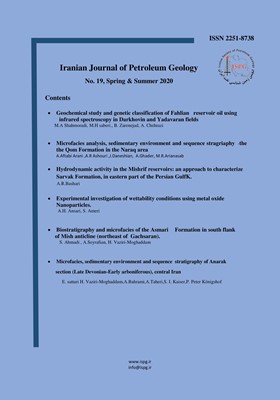Comparison of the function of conventional neural networks for estimating porosity in one of the southeastern Iranian oil fields
Subject Areas : Geoscience Fields in relation with Petroleum GeologyFarshad Toffighi 1 , parviz armani 2 , Ali Chehrazi 3 , َAndisheh Alimoradi 4
1 -
2 -
3 -
4 -
Keywords: seismic inversion, porosity estimation, MLFN, RBFN, PNN,
Abstract :
In the oil industry, artificial intelligence is used to identify relationships, optimize, estimate and classify porosity. One of the most important steps in evaluating the petrophysical parameters of the reservoir is to identify the porosity properties. The main purpose of this study is to compare the accuracy and generalizability of three multilayer feed neural networks (MLFNs), radius base function networks (RBFNs) and probabilistic neural networks (PNNs) to estimate porosity using seismic properties. In this regard, geological data of 7 wells were evaluated from an offshore oil field in Hindijan in the northwest of the Persian Gulf basin. Acoustic impedance was estimated using model-based inversion method and then the mentioned neural networks were designed using optimal seismic properties and evaluated by stepwise regression method. Finally, it became clear that the MLFN model did not work well for estimating porosity. PNN has the best performance accuracy in porosity interpolation, but RBFN generalizability is better.
[1] AMINI, A., MOVAHED, B., BEHZAD, ASIRI, H., and MARZAYI, TABESH, F., 2014, Design of Artificial Neural Network for Prediction of Porosity of Asmari Reservoir in Rag-Sefied Field Using Logarithmic and Porous Porosity Data: 3rd National Oil, Gas and Petrochemical Conference, Gachsaran, Iran.4-5.
[2] ANEES, M., 2013, Seismic attribute analysis for reservoir characterization: 10th Biennial International Conference and Exposition on the theme “Changing Landscapes in Geophysical Innovations”, India, 119-122.
[3] ASOODEH, M., and BAGHERIPOUR, P., 2013, Core porosity estimation through different training approaches for neural network: back-propagation learning vs. genetic algorithm: International Journal of Computer Applications, 63, 5:11–15.
[4] BEDI, J., and TOSHNIWAL, D., 2019, PP-NFR: an improved hybrid learning approach for porosity prediction from seismic attributes using non-linear feature reduction: Journal of Applied Geophysics, 166, 22-32.
[5] CAO, J., YANG, J., WANG, Y., WANG, D., and SHI, Y., 2015, Extreme Learning Machine for Reservoir Parameter Estimation in Heterogeneous Sandstone Reservoir: Mathematical Problems in Engineering, 287816, 1-10.
[6] CHOPRA, S., and MARFURT, K.J., 2007, Seismic Attributes for Prospect Identification and Reservoir Characterization: (chapter 1) 1st ed. Society of Exploration Geophysicists. 1-24
[7] ELKATANY, S., TARIQ, Z., MAHMOUD, M., and ABDULRAHEEM, A., 2018, New insights into porosity determination using artificial intelligence techniques for carbonate reservoirs: Petroleum Journal, 4, 4:1-11.
[8] EZEKWE, J.N., 2003, Applied Reservoir Management Principles with Case Histories: SPE Annual Technical Conference and Exhibition. Colorado. 5-8.
[9] FAUSETT, L.V., 1994, Fundamentals of Neural Networks Architectures: Algorithms and Applications (chapter 1) 1st ed. Pearson. 3-4
[10] GHARECHELOU, S., AMINI, A., KADKHODAIE-ILKHCHI, A., and MORADI, B., 2015, An integrated approach for determination of pore-type distribution in carbonate-siliciclastic Asmari Reservoir, CHESHMEH-KHOSH Oilfield, SW Iran: Journal of Geophysics and Engineering, 12, 793-809.
[11] GHAZBAN, F., 2007, Petroleum Geology of the Persian Gulf (chapter 9) 1st ed. Tehran, Tehran University and National Iranian Oil Company publication, 586-587.
[12] GHOLAMI, A., and ANSARI, H.R., 2017, Estimation of porosity from seismic attributes using a committee model with bat-inspired optimization algorithm: Journal of Petroleum Science and Engineering, 152, 238-249. [13]
HOSSEINI, A., ZIAII, M., KAMKAR ROUHANI, A., ROSHANDEL, A., GHOLAMI, R., and HANACHI, J., 2011, Artificial Intelligence for prediction of porosity from Seismic Attributes: Case study in the Persian Gulf: Iranian Journal of Earth Sciences, 3. 2:168-174. [14]
HUUSE, M., and FEARY, D.A., 2005, Seismic inversion for acoustic impedance and porosity of Cenozoic cool-water carbonates on the upper continental slope of the Great Australian Bight: Marine Geology, 215, 3-4:123-134. [15]
ITURRARÁN-VIVEROS, U., and PARRA, J.O., 2014, Artificial Neural Networks applied to estimate permeability, porosity and intrinsic attenuation using seismic attributes and well-log data: Journal of Applied Geophysics, 107, 45-54. [16]
MCCULLOCH, W.S., and PITTS, W., 1943, A logical calculus of the ideas immanent in nervous activity: Bulletin of Mathematical Biophysics, 5, 115–[17] MCPHEE, C., REED, J., and ZUBIZARRETA, I., 2015, Core Analysis: A Best Practice Guide, (chapter 8) 1st ed. Edinburgh, Elsevier Publication, 347-[18]
MOJEDDIFAR, S., KAMALI, G., RANJBAR, H., and SALEHIPOUR BAVARSAD, B., 2014, A comparative study between a pseudo-forward equation [pfe] and intelligence methods for the characterization of the North Sea reservoir: International Journal of Mining and Geo-Engineering, 48. 2:173–[19] ORR, M.J., 1996, Introduction to Radial basis function neural networks: Research Report for the Institute of Adaptive and Neural Computation, University of Edinburgh. 9-11.
[20] POWELL, M.J.D., 1987, Radial basis functions for multivariable interpolation: a review, Algorithms for Approximation: Clarendon. 143– 167.
POWELL, M.J.D., 1987, Radial basis functions for multivariable interpolation: a review, Algorithms for Approximation: Clarendon. 143– 167. [21] RONEN, S., SCHULTZ, P.S., HATTORI, M., and CORBETT, C., 1994, Seismic guided estimation of log properties, Part 1, 2 and 3: The Leading Edge, 13: 305-10, 674-678, 770-776. [22]
RUSSELL, B.H., 1988, Introduction to seismic inversion methods (Chapter 8) 1th ed. Calgary, Society of exploration Geophysicist, 1-14. [23]
RUSSELL, B.H., 2004, The application of multivariate statistics and neural networks to the prediction of reservoir parameters using seismic attributes: Ph.D. thesis, Faculty of Graduate Studies, Dissertation University of Calgary. 17-18. [24]
SOLEIMANI, B., BAHADORI, A., and MENG, F., 2013, Microbiostratigraphy, microfacies and sequence stratigraphy of upper cretaceous and Paleogene sediments, Hendijan oil field, Northwest of Persian Gulf, Iran: Natural Science, 5. 11:1165-1182. [25]
SPECHT, D.F., 1990, Probabilistic neural networks: Neural Networks, 3, 1:109–118. [26]
TARANTOLA, A., 2005, Using the Solution of the Inverse Problem, 1st ed. Paris, Society for Industrial and Applied Mathematics, 37-38. [27] YAZDANIAN, J., and NOORI, B., 2007, Geological Final Report-Well HD_7, Iranian Offshore Oil Company


